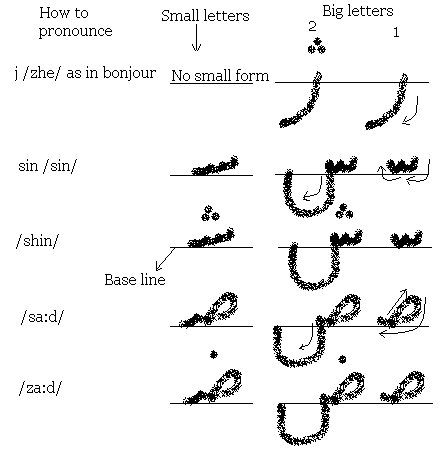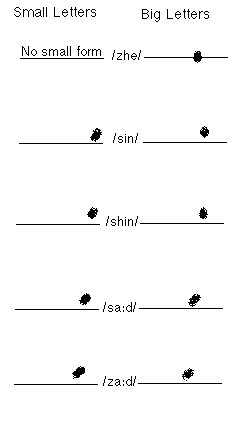
Persian Lesson 5 – Letters /zhe/ to /za:d/
Persian Letters /zhe/ to /za:d/
Welcome back!
This lesson is about learning Persian Letters /zhe/ to /za:d/. Have you studied the previous lessons carefully? It’s wonderful if the answer is yes! If not, please study those lessons before taking care of the new ones.
Last week, we covered five more letters. Do you remember them? They are
![]() ,
, ![]() ,
, ![]() ,
, ![]() ,
, ![]() . If you need to listen to these letters again, click here.
. If you need to listen to these letters again, click here.
All right. Today, we are going to learn five more letters. Ready?

14. ![]() This letter has no English equivalent. I am sure all of you know the pronunciation of J in French words such as ‘Bonjour!’ So, this letter is called /zhe/. /zh/ as j in ‘bonjour’ and /e/ as e in set. This letter has one form only. Need to hear? Click here.
This letter has no English equivalent. I am sure all of you know the pronunciation of J in French words such as ‘Bonjour!’ So, this letter is called /zhe/. /zh/ as j in ‘bonjour’ and /e/ as e in set. This letter has one form only. Need to hear? Click here.
When combined with vowels, it may be pronounced as ![]() . Need help? Click here.
. Need help? Click here.
Note: as you have noticed, to write the way letters are pronounced (phonetic alphabet), sometimes, I have used the combination of two English letters such as /zh/ for ![]() , or /kh/ for
, or /kh/ for ![]() . These are the Latin -based Persian that enable you communicate with Persian-speaking people without having to write in Persian. For the time being, you have to learn these phonetic alphabets along with each letter. Nevertheless, I do not recommend you to use these in your writing, at least at this stage. You will become more familiar with this later. In the meantime, please try to write Persian letters using the Let’s writepage.
. These are the Latin -based Persian that enable you communicate with Persian-speaking people without having to write in Persian. For the time being, you have to learn these phonetic alphabets along with each letter. Nevertheless, I do not recommend you to use these in your writing, at least at this stage. You will become more familiar with this later. In the meantime, please try to write Persian letters using the Let’s writepage.
15. ![]() –
– ![]() This is called sin /sin/.
This is called sin /sin/.
When combined, it may be pronounced as ![]() . Need help? Click here.
. Need help? Click here.
Note: like ![]() and
and ![]() , when combined with vowels,
, when combined with vowels, ![]() and
and ![]() have the same pronunciation. That is to say, they have the same pronunciation, but different functions. Currently, you don’t need to learn about these differences. Just learn the letters as you are being told.
have the same pronunciation. That is to say, they have the same pronunciation, but different functions. Currently, you don’t need to learn about these differences. Just learn the letters as you are being told.
16. ![]() –
– ![]() This is called /shin/. Here.
This is called /shin/. Here.
When combined, it may be pronounced as ![]() . Here.
. Here.
17. ![]() –
– ![]() This is called /sa:d/. Here.
This is called /sa:d/. Here.
When combined, it may be pronounced as ![]() . Click here to listen.
. Click here to listen.
Note: These three letters (![]() ,
, ![]() ,
, ![]() ), when combined, have the same pronunciation, and of course with different functions. In the meantime, just learn the letters and don’t worry about their differences.
), when combined, have the same pronunciation, and of course with different functions. In the meantime, just learn the letters and don’t worry about their differences.
18. ![]() –
– ![]() This is called /za:d/. Here.
This is called /za:d/. Here.
When combined, it may be pronounced as ![]() . Click here to listen.
. Click here to listen.
Like the previous ones, ![]() ,
, ![]() , and
, and ![]() , when combined, have the same pronunciation.
, when combined, have the same pronunciation.
Note: As I have reminded you repeatedly, you don’t really need to worry about the different functions of the letters that have the same pronunciations. Just try to learn the letters as you are being told. Nothing more.

If you need to listen to the names of today’s letters, from number 14 to number 18, click here.






Leave a Reply
Your email address will not be published. Required fields are marked *
All Comments (3)
A New Trend In Porn Stars kayleigh wanless playboy
ellen
Pouria